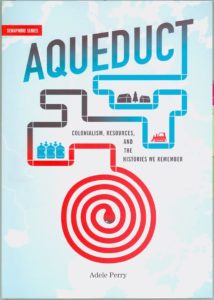Book Review: Aqueduct: Colonialism, Resources, and the Histories We Remember
It is now 100 years since the opening of the completed Winnipeg aqueduct brought fresh water to a growing city through an act of colonial violence and forgetting. Perry’s Aqueduct: Colonialism, Resources, and the Histories We Remember is a concise examination of this process.
Written shortly after the 2015 promise by the newly elected Liberal government to fund a road (Freedom Road) that would finally connect Shoal Lake 40 to the mainland, Aqueduct illustrates how local colonialism was intimately tied to the larger displacement of Indigenous peoples from lands and water.
Perry deftly shows that Winnipeg city boosters drew upon Ottawa’s complacency and disregard of Indigenous rights and interests, American expertise, as well as the larger western narratives of progress and terra nullius throughout the process of creating the aqueduct. The act of forgetting or remembering, discussed in Aqueduct, examines how the commemorations of the Winnipeg aqueduct celebrated western innovation, construction, forward thinking, public health, as well as many other interconnected narratives, while entirely neglecting to consider the impact on Indigenous people. Remembering the aqueduct became a process of forgetting the people of Shoal Lake 40 and Iskatewizaagegan.
Throughout Aqueduct, Perry points out how language is used to dispossess the Anishinaabeg of Shoal Lake. She notes how words such as “a few Indians” or “largely uninhabited” were utilized to minimize and create as well as sustain a notion among Settlers that the land was empty and ready for habitation or development. Perry also shows that this language remained consistent from the late 1800s to the 1950s and influences contemporary ignorance.
Moreover, the book shows the complicity of Indian Affairs in the process despite its legal obligations to ‘protect’ First Nations’ interests. Simply, Indian affairs sold Shoal Lake 40 reserve lands for a pittance without consultation or surrender under section 46 of the Indian Act.
Finally, it is readily apparent throughout each chapter how colonialism created the aqueduct and the narratives surrounding it, as well as how people in contemporary Winnipeg failed to register the impact on the people at the source of their water. As such, Winnipeg and its waters remain a centre of colonial control and expropriation.
Overall, this an excellent work that focusses on the local while placing it within the larger narrative of Canadian and western colonialism. It is a quick read; perfect for anyone, particularly undergraduate classes in colonialism, urban development, history, and Indigenous studies.
Adele Perry, Aqueduct: Colonialism, Resources, and the Histories We Remember, Winnipeg: ARP Books, 2017.



